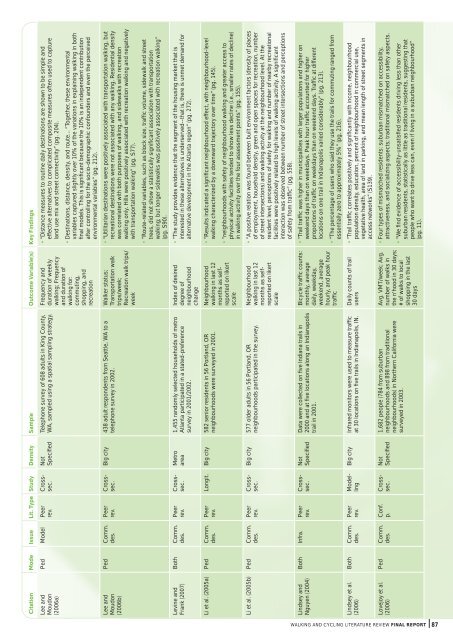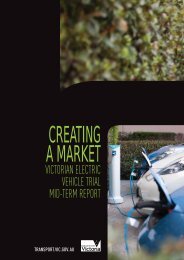Walking and Cycling International Literature Review - Department of ...
Walking and Cycling International Literature Review - Department of ...
Walking and Cycling International Literature Review - Department of ...
Create successful ePaper yourself
Turn your PDF publications into a flip-book with our unique Google optimized e-Paper software.
Citation Mode Issue Lit. Type Study Density Sample Outcome Variable(s) Key Findings<br />
Lee <strong>and</strong><br />
Moudon<br />
(2006a)<br />
Ped Model Peer<br />
rev.<br />
Not<br />
Specified<br />
Telephone survey <strong>of</strong> 608 adults in King County,<br />
WA, sampled using a spatial sampling strategy.<br />
Frequency <strong>and</strong><br />
duration <strong>of</strong> weekly<br />
walking; Frequency<br />
<strong>and</strong> duration <strong>of</strong><br />
walking for:<br />
commuting,<br />
shopping, <strong>and</strong><br />
recreation<br />
• “Distance measures to routine daily destinations are shown to be simple <strong>and</strong><br />
effective alternatives to complicated composite measures <strong>of</strong>ten used to capture<br />
l<strong>and</strong> use mix <strong>and</strong> street connectivity” (pg. 204).<br />
• Destinations, distance, density, <strong>and</strong> route... “Together, these environmental<br />
variables captured slightly over 10% <strong>of</strong> the variations in explaining walking in both<br />
final models. This is significant because the 10% is an independent contribution<br />
after controlling for the socio-demographic confounders <strong>and</strong> even the perceived<br />
environmental variables” (pg. 212).<br />
Lee <strong>and</strong><br />
Moudon<br />
(2006b)<br />
Ped Comm.<br />
des.<br />
Peer<br />
rev.<br />
Big city 438 adult respondents from Seattle, WA to a<br />
telephone survey in 2002.<br />
Walker status;<br />
Transportation walk<br />
trips/week;<br />
Recreation walk trips/<br />
week<br />
• “Utilitarian destinations were positively associated with transportation walking, but<br />
recreational destinations were not associated with any walking. Residential density<br />
was correlated with both purposes <strong>of</strong> walking, <strong>and</strong> sidewalks with recreation<br />
walking only. Hills were positively associated with recreation walking <strong>and</strong> negatively<br />
with transportation walking” (pg. S77).<br />
• “Route-related variables, such as block size, traffic volume, sidewalk <strong>and</strong> street<br />
trees, did not show a statistically significant association with transportation<br />
walking; but longer sidewalks was positively associated with recreation walking”<br />
(pg. S90).<br />
Levine <strong>and</strong><br />
Frank (2007)<br />
Both Comm.<br />
des.<br />
Peer<br />
rev.<br />
Crosssec.<br />
Crosssec.<br />
Crosssec.<br />
Metro<br />
area<br />
1,455 r<strong>and</strong>omly selected households <strong>of</strong> metro<br />
Atlanta participated in a stated-preference<br />
survey in 2001/2002.<br />
Index <strong>of</strong> desired<br />
degree <strong>of</strong><br />
neighbourhood<br />
change<br />
• “The study provides evidence that the segment <strong>of</strong> the housing market that is<br />
interested in these alternatives is underserved--that is, there is unmet dem<strong>and</strong> for<br />
alternative development in the Atlanta region” (pg. 272).<br />
Li et al. (2005a) Ped Comm.<br />
des.<br />
Peer<br />
rev.<br />
Longit. Big city 582 senior residents in 56 Portl<strong>and</strong>, OR<br />
neighbourhoods were surveyed in 2001.<br />
Neighbourhood<br />
walking in last 12<br />
months as selfreported<br />
on likert<br />
scale<br />
• “Results indicated a significant neighbourhood effect, with neighbourhood-level<br />
walking characterized by a downward trajectory over time” (pg. 145).<br />
• “neighbourhoods with safety <strong>of</strong> neighbourhood walking <strong>and</strong> greater access to<br />
physical activity facilities tended to show less decline (i.e., smaller rates <strong>of</strong> decline)<br />
in walking activity over the four assessment points” (pg. 155).<br />
Li et al. (2005b) Ped Comm.<br />
des.<br />
Peer<br />
rev.<br />
Crosssec.<br />
Big city 577 older adults in 56 Portl<strong>and</strong>, OR<br />
neighbourhoods participated in the survey.<br />
Neighbourhood<br />
walking in last 12<br />
months as selfreported<br />
on likert<br />
scale<br />
• “A positive relation was found between built environment factors (density <strong>of</strong> places<br />
<strong>of</strong> employment, household density, green <strong>and</strong> open spaces for recreation, number<br />
<strong>of</strong> street intersections) <strong>and</strong> walking activity at the neighbourhood level. At the<br />
resident level, perceptions <strong>of</strong> safety for walking <strong>and</strong> number <strong>of</strong> nearby recreational<br />
facilities were positively related to high levels <strong>of</strong> walking activity. A significant<br />
interaction was observed between number <strong>of</strong> street intersections <strong>and</strong> perceptions<br />
<strong>of</strong> safety from traffic” (pg. 558).<br />
Lindsey <strong>and</strong><br />
Nguyen (2004)<br />
Both Infra. Peer<br />
rev.<br />
Not<br />
Specified<br />
Data were collected on five Indiana trails in<br />
2000 <strong>and</strong> at five locations along an Indianapolis<br />
trail in 2001.<br />
Bicycle traffic counts:<br />
monthly, average<br />
daily, weekday,<br />
weekend, average<br />
hourly, <strong>and</strong> peak hour<br />
traffic<br />
• “Trail traffic was higher in municipalities with larger populations <strong>and</strong> higher on<br />
weekend days than on weekdays. Peak hour traffic accounted for higher<br />
proportions <strong>of</strong> traffic on weekdays than on weekend days. Traffic at different<br />
locations on one trail in Indianapolis varied considerably” (pg. 213).<br />
• “The percentage <strong>of</strong> users who said they use the trails for commuting ranged from<br />
essentially zero to approximately 5%” (pg. 216).<br />
Lindsey et al.<br />
(2006)<br />
Both Comm.<br />
des.<br />
Peer<br />
rev.<br />
Big city Infrared monitors were used to measure traffic<br />
at 30 locations on five trails in Indianapolis, IN.<br />
Daily counts <strong>of</strong> trail<br />
users<br />
• “Trail traffic correlates positively <strong>and</strong> significantly with income, neighbourhood<br />
population density, education, percent <strong>of</strong> neighbourhood in commercial use,<br />
vegetative health, area <strong>of</strong> l<strong>and</strong> in parking, <strong>and</strong> mean length <strong>of</strong> street segments in<br />
access networks” (S139).<br />
Lovejoy et al.<br />
(2006)<br />
Ped Comm.<br />
des.<br />
Conf.<br />
p.<br />
Crosssec.<br />
Modelling<br />
Crosssec.<br />
Not<br />
Specified<br />
1,682 people (784 from suburban<br />
neighbourhoods <strong>and</strong> 898 from traditional<br />
neighbourhoods) in Northern California were<br />
surveyed in 2003.<br />
Avg. VMT/week; Avg.<br />
number <strong>of</strong> walks in<br />
the n'hood in 30 days;<br />
# <strong>of</strong> walks to local<br />
shopping in the last<br />
30 days<br />
• Four types <strong>of</strong> mismatched residents: suburban mismatched on accessibility,<br />
attractiveness, <strong>and</strong> socializing aspects; traditional mismatched on safety aspects.<br />
• “We find evidence <strong>of</strong> accessibility-unsatisfied residents driving less than other<br />
suburban residents, statistically as little as traditional residents, suggesting that<br />
people who want to drive less can, even if living in a suburban neighbourhood”<br />
(pg. 11).<br />
WALKING AND CYCLING LITERATURE REVIEW FINAL REPORT 87

















